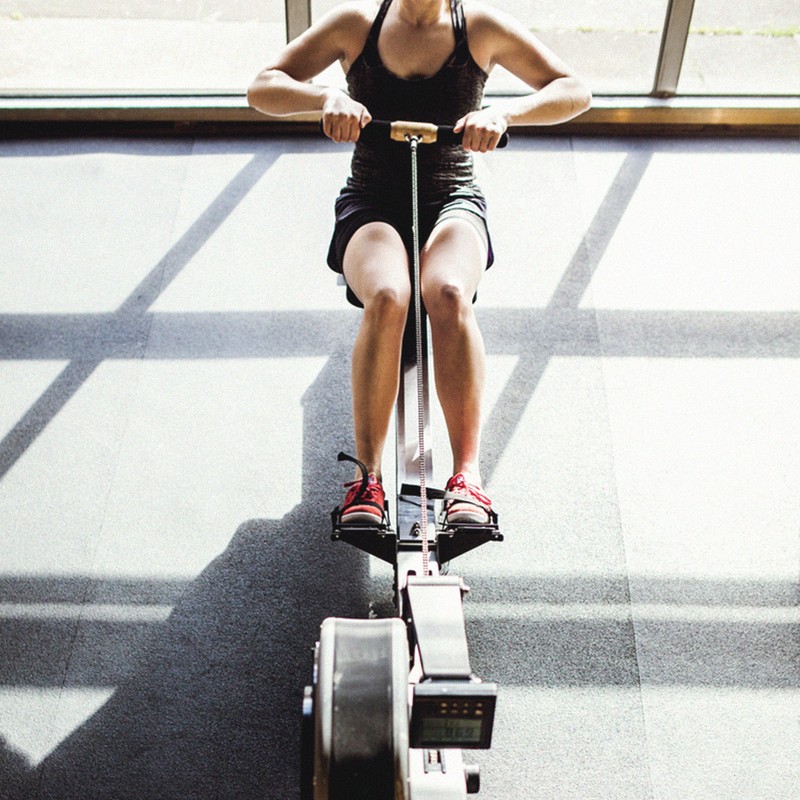A PT’s Guide To Rowing
Why It’s A Great Workout…
It Uses 85% Of Your Muscles: “Rowing is the ultimate full-body workout as it uses almost every muscle in your body. Due to the physical pattern of rowing, it works your lower body, core and upper body in unison. Whether you’re looking to build definition in your legs, tone your glutes or build stronger abs, rowing ticks all the boxes.” – Pelé Zachariah, head of performance at ROWBOTS
It Builds Strength & Tones: “The rower is one of the only pieces of gym kit that allows you to work on your fitness levels while simultaneously building strength and endurance. Plus, the movement pattern of rowing transfers over to other fitness movements, such as deadlifts and squats, as well as exercises that work the core, meaning you’ll become both a stronger rower and build fitness in other areas too.” – Pele
It’s Low Impact: “Despite offering a challenging workout, rowing is low impact. This means it allows you to push hard without pounding or stressing the joints, especially your ankles, knees and hips.” – Pele
It’s A Mindful Way To Work Out: “The smooth, repetitive motion of rowing forces you to be mindful and present during each and every stroke, which is a great way of finding your flow and being in the moment.” – Pele
How To Get The Most Out Of It…
Nail The Technique: “Don’t be fooled into thinking rowing is an upper-body workout – a solid rowing stroke is produced by your legs. By using the upper body to pull the stroke too soon, you’ll not only row inefficiently and fatigue your upper body, but you’ll also risk injury. Think push, not pull – rowing should be 60% legs, 30% hips/midline and 10% arms.” – Lucie Cowan, master trainer at Third Space
Know You’re In Control: “When you row, you’re in charge of the intensity you put into the exercise, and how much effort you put in – completely the opposite of a treadmill moving underneath you at a set pace. As such, you can target a multitude of goals in one machine. The damper controls how much air is allowed in and out of the filter – the higher you set it, the more difficult it will be to pull the chain. Lower settings make it easier and quicker to row, which is a good place to start. For a slower but longer workout, use a level five. For a shorter, fast-paced workout, increase it to an eight.” – Lucie
Go Slower Than You Think: “It’s far more effective to do fewer, longer strokes than shorter, quicker strokes. Many of us default to short strokes when we get tired, but this movement pattern actually creates more fatigue. For optimal efficiency, keep each stroke smoother, for longer.” – Lucie
/https%3A%2F%2Fsheerluxe.com%2Fsites%2Fsheerluxe%2Ffiles%2Farticles%2F2022%2F06%2Frowing-101-image-row.png?itok=y6vZL97y)
Give Yourself 20 Minutes: “The 2,000-metre row is the gold standard test for rowing athletes as it’s the official distance used in rowing championships. It’s a solid fitness barometer for novice rowers. As a rule of thumb, aim to work towards 500m in roughly two minutes. Splitting the 2,000m into four blocks of 500, and combining each block with one strength and one core exercise, is a great option for a 20-minute workout.” – Lucie
Test Yourself: “Aim to row anywhere between 1,000-6,000m in six minutes. This is a great endurance benchmark to see where you’re currently at. Build other workouts off the back of this and come back to it from time to time to reassess fitness levels. Start by warming up for two minutes at a six out of ten effort, rest for one minute before the test, and then start at a good pace before settling into a rhythm. Try to keep enough in the tank to finish hard at the end.” – Lucie
Build It Up: “If you’re a beginner, start by rowing a couple of times a week and focus on building technique and efficiency. From there, progress to three or four times a week, varying the types of workouts to train different energy systems and to keep things interesting. Try incorporating other equipment such as dumbbells, kettlebells or your own bodyweight to mix things up.” – Lucie
Always Cool Down: “The best way to cool down on the rower is to drop the pace right down and move slowly for five to ten minutes, making sure to maintain your form. This will allow you to regulate your breathing and heart rate. Then, spend a few minutes stretching your glutes (try a pigeon stretch), hamstrings (downward dog), your back (cat cow) and quads (kneeling quad stretch), as these areas can feel tight after an intense session.” – Pele
Where To Try It…
THIRD SPACE: Book in for a Formula 3 class, a high-intensity circuit class that incorporates cardio and strength with free weights.
Visit ThirdSpace.London
ROWBOTS: Combining rowing, floor exercises and motivational and mindfulness techniques, the ROWBOTS workout is unlike anything you’ve tried before.
Visit ROWBOTS.co.uk
MILO AND THE BULL: Based south of the river? Check out this boutique studio, which offers 45-minute interval-based rowing classes.
Visit MiloAndTheBull.com
CORE COLLECTIVE: Row/Sweat is a fast-paced class that combines plyometrics with weighted exercises and rowing to kickstart fitness levels.
Visit Core-Collective.co.uk
ONE LDN: This industry-favourite studio uses rowing machines in its renowned classes to build a stronger, more toned body.
Visit ONELDN.com
DISCLAIMER: Features published by SheerLuxe are not intended to treat, diagnose, cure or prevent any disease. Always seek the advice of your GP or another qualified healthcare provider for any questions you have regarding a medical condition, and before undertaking any diet, exercise or other health-related programme.
DISCLAIMER: We endeavour to always credit the correct original source of every image we use. If you think a credit may be incorrect, please contact us at info@sheerluxe.com.


